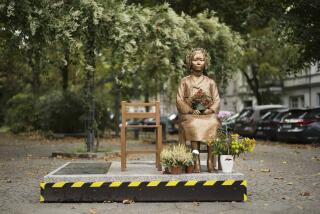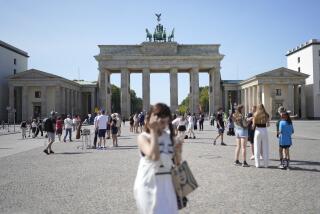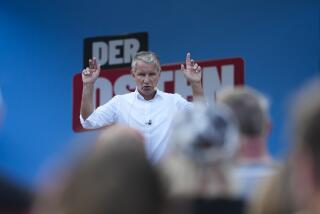EUROPE: FIVE YEARS LATER : Ludwigsfelde, Germany : . . Seeking for Middle Ground in the East : Capitalism has proven a roller coaster of hope and despair, bringing joblessness and crime along with new investment.
- Share via
LUDWIGSFELDE, Germany — This community of 23,000 was a Communist poster-town during the East German years: an adequate if dreary-looking settlement built up around a single huge truck factory, a place where most people enjoyed cradle-to-grave security in drab, prefabricated cement apartment blocks thrown up by the state.
Today, life is far more uncertain and also far more exciting. Over the past five years, Ludwigsfelde, less than an hour’s drive south of Berlin, has ridden a roller coaster of hopes and disappointments.
Consider the way that the past five years have turned out for Klaus Perlet and Reinhold Schulz, both former truck mechanics in Ludwigsfelde.
Perlet, for his part, has the luxury of contemplating his transformation from socialist worker-bee to entrepreneur in the comfort and style of the skylighted head office of the metal-working firm he has owned since 1992.
“I have fun,” says the heavyset Perlet, sitting amid a potted-plant decor and blueprints spread across his drafting table. “I love the feeling of making my own decisions, of finding the way for this little business. But I have two souls in my chest. One of them is the soul of a proprietor, who has to find a place in a very competitive market. The other is just the soul of a human being, trying to work with others. These two souls can’t always be reconciled.”
Meanwhile, across town, just off the parking lot that passes for Ludwigsfelde’s town square, Schulz is taking advantage of the last lingering rays of autumn sunshine to drink a little beer outdoors and watch the world go by.
For Schulz, there is no point in soul-searching these days about free markets and the human condition; there is barely any point in getting out of bed in the morning.
The end of East German communism has spelled for him not opportunity, but a chain reaction that started with the loss of his good factory job and ended up with life in a flophouse.
“I lived better before than I do now,” says Schulz, who was rescued from the street by a fellow jobless man, Werner Nowark, and brought home to the unheated, unlighted apartment the two now share. Schulz lost his old flat when the owner renovated the building and raised the rent; the so-called guest house where he was subsequently accommodated was torn down, and in the confusion that marked eastern Germany in the early 1990s, he never managed to find another place of his own.
“Sure, I couldn’t ever get bananas in East Germany, and the coffee cost more,” Schulz says. “A color TV set cost a fortune. But I had work. I could wake up in the morning and look forward to the day. I had something to be happy about. Now I wake up and I say to myself, ‘What do I do with myself today?’ ”
They are extremes, perhaps, the two mechanics: one who commands a staff of nine and the other approaching a state of utter dereliction. Yet the picture of eastern Germany five years after the fall of the Berlin Wall includes many examples of extreme adaptation and failure, and a whole spectrum of people in between: rising go-getters who drive cars with radio phones plugged into the dashboard, embittered 50-year-olds who will never work again, frightened elderly on scanty state pensions and tough Rosie-the-Riveter types who now stay home unwillingly with small children.
A look around eastern Germany today turns up any number of Ludwigsfeldes, places where East German economic planners once decided to found single industries--electronics, perhaps, or steel-milling--and where the local economies collapsed when communism failed and steady Eastern Bloc markets dried up.
Ludwigsfelde is better off today than many of these central-planning outposts. Its new, post-Communist administrators have managed to court a handsome number of private investments--altogether, $510 million worth of new business through 1993--and to put a respectable percentage of the able-bodied adult population back to work. It has a dynamic mayor, Heinrich Scholl, a former circus executive and a free thinker who chafed under East German-style communism. He has worked with relish since the regime’s collapse to fulfill capitalism’s textbook promise.
But most people in Ludwigsfelde are conscious of the five years of ceaseless struggle endured just to bring their community this far, and of how much further they still have to go before life ever feels secure again.
The overall unemployment rate here is about 10%, significantly lower than in the rest of eastern Germany, but the figure is kept down artificially by make-work schemes. A depressing 65% of the jobless are skilled women.
Some people have simply given up on the town: Hundreds have moved away since 1989. An estimated 10% to 15% of the townspeople still support the former Communist Party, reorganized and renamed the Party of Democratic Socialism. Others take out their frustrations by engaging in violence against foreigners and vagrants.
“I would call the mood in this city right now one of repressed optimism,” said Gerhard Birk, a longtime Ludwigsfelde resident who now works as an archivist for the state government. “The place is changing now from a simple factory settlement to a town in its own right, with its own typical flair. The direction is upward, but we are moving very gradually.”
“I feel satisfied when I bump into people I knew in the old days who are working again now,” added Karl-Heinz Reifenberger, a former East German accountant who is now charged with privatizing what’s left of the former truck works. “But, when I walk by the old production halls that are still standing empty, I feel frustrated and bitter.”
Ludwigsfelde traces its origins to 1750, but it really came into its own as a town in 1936, when Daimler-Benz and Adolf Hitler’s aviation ministry chose it as the site of a vast, strategically decisive fighter-aircraft factory. The town boomed as Daimler recruited young workers from across Germany and set them to work building warplanes. After universal conscription was imposed, Daimler kept the factory going with forced labor from concentration camps and with POWs.
In 1945, the advancing Red Army captured Ludwigsfelde, dismantled the aircraft factory and carted the hardware back as war reparations. When the German Democratic Republic opened for business in 1949, the new government faced a problem: Ludwigsfelde had a population of skilled industrial artisans and no work for them to do. So the central planners brought in industry: first, a state-owned aircraft-engine factory, and later, after the prototype aircraft crashed, a huge truck factory called IFA Automobilwerk Ludwigsfelde.
Within East Germany’s planned economy, IFA emerged as a model factory, and Ludwigsfelde again thrived as a model town. Most of IFA’s output was exported throughout the Eastern Bloc and the Third World, although East Germany had plenty of farm produce to get to market, so there was a big domestic demand too.
By the time the Berlin Wall came down, nearly 10,000 people were punching the clock on IFA’s sprawling, 540-acre grounds. Schulz recalls that as a skilled mechanic he made 1,100 eastmarks per month--in an economy where a standard apartment rented for 40 eastmarks per month.
Factory management and the government, tightly intertwined, saw to all the bedrock wants of the townspeople. IFA administered the local government, distributed heat, water and power, ran a hotel, operated most of the local day-care centers and even provided all-important wurst out of its own butcher shop.
As long as you didn’t step out of line, life here was comfortable--so much so that the unrest that swept the larger East German cities in 1989 never really touched Ludwigsfelde.
“I got the feeling that the Wende (the Great Change) was happening someplace else, and not in Ludwigsfelde,” says Ute Schmidt, a former teacher who is now Ludwigsfelde’s equal rights commissioner.
Even when the East German regime collapsed before their eyes, she says, people in Ludwigsfelde innocently assumed that not much trouble would come their way because of the changes.
“People said, ‘Now we can travel,’ or ‘now we’ll need hard currency,’ but it didn’t occur to them that their individual lives would be affected,” she says. “Nobody was talking about the danger of losing a job, or not being able to find an apartment. It just wasn’t a topic.”
Even when orders stopped coming into the truck factory, when production ground to a standstill and word went out that entire departments might have to be closed, people still did not grasp quite what was happening. Some people--women, in particular, says Schmidt--grabbed at their pink slips greedily, delighted at the chance for some time off and assuming in their innocence that they would always be able to find work later. Unemployment in East Germany had been unknown.
“At that time, women had no idea what it really meant to stay home,” says Schmidt, pointing out that virtually 100% of Ludwigsfelde’s working-age women had factory jobs and sent their children to day care. “They didn’t know how hard it would be to come back later. . . . When I look back now, I think that our mistake was having started from the assumption that we would improve upon what we had (under communism). It didn’t occur to us that we should have been defending our position.”
The blissful optimism was nurtured, in particular, by Daimler-Benz, which suddenly returned to Ludwigsfelde, seeking the return of its old World War II factory site.
The land claim failed--the expropriation was deemed a valid and irreversible sanction for Daimler’s wartime use of forced labor--but then Daimler’s flagship subsidiary, Mercedes-Benz, announced that it would come to Ludwigsfelde just the same, buying a separate tract of land and building Europe’s biggest truck factory from the ground up, with jobs for 4,000 of IFA’s former work force.
“People just assumed Mercedes-Benz would come and save their lives,” Schmidt remembers. “They didn’t realize Mercedes would come only on the condition that it could make a profit.”
And as it turned out, Mercedes came to the conclusion that it could not make a profit on trucks here--not, at least, in a new factory. In the end, it bought out just a portion of the old IFA works and has hired only about 1,400 people.
“When the big Mercedes-Benz project burst like a balloon, it triggered a wave of disappointment and a wave of outward migration,” says Birk, the archivist.
Finally, reality sank in: Capitalism would not be an uncomplicated good for Ludwigsfelde.
Hand in hand with the federal government, people such as Reifenberger, the privatization officer, began the slow, frustrating work of selling off piecemeal the factory that had once treated them so protectively. Skilled workers, such as Schulz, began to understand that they might never hold regular jobs again.
Schmidt says she began receiving a stream of women in her office, former forklift drivers or metal stampers, complaining that they were going out of their minds at home.
“Never, ever again will we have as many working women as in the German Democratic Republic,” she says. “And never again will we have working conditions that are so fair for women.”
Still, Reifenberger, whose official title is the baleful-sounding Representative of the Liquidator, has managed to attract more than a dozen West German investors to the old factory grounds. They produce everything from aircraft turbines to armored cars. These new investors employ about 3,800 of the 10,000 who used to work here.
But even as it registers the entrepreneurial successes of such native sons as Klaus Perlet, Ludwigsfelde must come to terms with the likes of Reinhold Schulz, who spends his days gathering firewood for the stove and his nights warding off neo-Nazi street toughs.
About two years ago, he reports, skinheads in the town set a 65-year-old acquaintance on fire; the man later died in the hospital. Hooligans have smashed all the windows in Schulz’s apartment.
Skinhead violence has flared in the east since German unification, but until about 1993, it was generally directed at foreigners who were perceived as stealing jobs from Germans. Now that there are stringent restrictions on who may enter Germany, the number of attacks has fallen off somewhat, but the target group has broadened to include anyone the attackers see as weaker than they: tramps, beggars, slum dwellers and other unfortunates.
Schulz’s story, sad as it is, is doubly shocking in a society where vagrants and bag ladies were until recently unknown.
“I never go out by myself, and I walk only on well-lit streets,” Schulz says. “If I could afford a gun, I would shoot the next person who hassles me. I don’t want to get set on fire, like my friend.”
“I’m no longer afraid of brutality from the state,” says local Pastor Bernd Schewe. “Now, I’m afraid of the violence directed from one individual against another. We didn’t have that in East Germany. You could walk in the street at midnight and nothing would happen to you. A woman could go into the forest alone and collect mushrooms. All this is gone now.”
More to Read
Sign up for Essential California
The most important California stories and recommendations in your inbox every morning.
You may occasionally receive promotional content from the Los Angeles Times.










